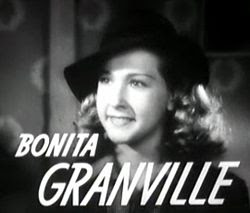
Saturday, December 29, 2007
B-Movie Detectives: Part 7

Thursday, December 27, 2007
The Lone Ranger Rides Again
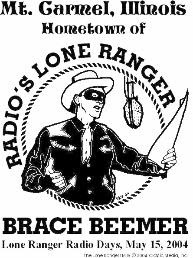
Man, this was a great show. Written and performed with enthusiasm, with great sound effects and strong scripts, it ran over 20 years on radio.
-
What made it such a great show? First, the back story of the Ranger is pretty cool. He was, of course, the sole surviver of a band of Texas Rangers that was ambushed by outlaws. Opting to hide his identity (and funding his activities with his secret silver mine), he dedicated his life to bringing justice to the West. He's cool. His best friend Tonto is cool. Even their horses, Scout and Silver, are cool.
-
Second, the show had wonderful production values, with great sound effects and a skilled set of actors to take the various character roles in each episode.
-
Third, it had the most perfect theme music ever. If hearing the William Tell Overture doesn't generate a vivid image of the Ranger astride Silver, galloping across the Southwestern desert, then you need to get your ears checked.
-
Fourth, it stayed true to the character of the Ranger. He pretty much has to be corny--a symbol of justice and the ideal that we are all our brother's keepers. Try to inject angst or to play the character tongue-in-cheek and you would lose your audience instantly.
-
From 1941 until the series ended in 1954, the Ranger was played with deep-voiced authority by Brace Beemer. Beemer's performance really captured the ideals that make the Ranger so appealing a character. (Much as Clayton Moore also did when the character came to television.)
-
Fifth, the stories were great. The Ranger was an expert pistol-shot, of course, but he doesn't depend purely on violence to get the job done. He uses his brains more often than his silver bullets, coming up with clever plans to trick or trap whatever outlaws he's after at the moment.
-
During the run of the series, there were also a number of extended story arcs. The Ranger once spent four consecutive episodes helping to protect the first transcontinental railroad from sabotage. A great two-parter involved three sets of bad guys trying to recover a map to a hidden cache of outlaw gold, with the Ranger caught in the middle. The Ranger and Tonto spent a dozen or so episodes on the waterfront in San Francisco, dealing with smugglers, thieves and a outbreak of plague.
-
The most extended story arc ran for about 60 episodes beginning in late 1941. An organization called the Legion of the Black Arrow was planning a campaign of terrorism and sabotage across the West, hoping to sow enough confusion to allow them to set up a dictatorship. For months, the Ranger and Tonto barely foiled one plot after another, dealing with hidden agents of the Black Arrow at every turn. On several occasions, they captured someone they thought was the leader, only to have their captive assassinated by someone even higher up before he could talk.
-
One last factor in the success of the Lone Ranger was announcer Fred Foy. It was Foy who asked that we "Return with us now to those thrilling days of yesteryear" at the beginning of every episode. Foy was a wonderful announcer and an integral part of the show, able to jump in with vivid and exciting third person narration whenever needed.
-
We are fortunate that so many Lone Ranger episodes have survived today. They are just as entertaining to listen to now as they were when they aired over half-a-century ago. The Lone Ranger radio show gives us some of the best storytelling ever.
Friday, December 21, 2007
B-Movie Detectives: Part 6

What makes Mr. Moto such an interesting character is the curious combination of his unfailing politeness towards everyone he meets and his willingness to act with ruthless violence when he decides such violence is necessary.
Wonderfully played by Peter Lorre in 8 movies, Moto is a just plain cool guy. He's good at deductive reasoning, he's an expert in art, a master of disguise, and a skilled hand-t0-hand combatant. In the first film, Think Fast, Mr. Moto, he turns out to be the owner of a Japanese import company, dabbling in detective work both as a hobby and to look after his own business interests.
In later films, he's working for a vaguely-defined organization called the "International Police," often going undercover to snag international crooks or spies. As mentioned above, one of the things that make him stand out was his inate ruthlessness. In many of the movies, Moto is called upon to use deadly force. On at least two occasions, he sets things up to get one bad guy to murder another. He's a lot more willing to pull a gun and actually use it than Charlie Chan ever was.
Then there's Mr. Moto's Gamble. This was originally meant to be a Charlie Chan film, but when Warner Oland got too sick to continue filming, it was quickly re-written to be a Moto film (both series were produced by 20th Century Fox). It's a nice little whodunit: Moto is teaching a criminology course in New York and is asked to help investigate a murder at a boxing ring. Helping him out is Lee Chan, Charlie's number one Son, who was one of Moto's students. Lee is played with humor and charm by Keye Luke, who also played the role in the Chan films. The niftiest thing about the movie is establishing that Charlie Chan and Mr. Moto both exist in the same universe.
The Hungarian-born Lorre didn't use heavy make-up to play Moto. Instead, he just slicked his hair back and donned glasses. Lorre, one of the best character actors of his time, made this work perfectly. His stunt double, Johnny Kascier, helped stage energetic, fun fight scenes.
With strong stories that range from murder mysteries to espionage thrillers, the Moto series is one of most entertaining examples of the genre. They rank up there with the best Chan films, but have their own unique feel to them. The two series complement each other nicely--it's really not surprising that the two men do indeed exist in the same universe.
Tuesday, December 18, 2007
B-Movie Detectives: Part 5

Torchy Blane, a spunky, very pretty girl newspaper reporter, used to be a thin, perpetually drunk guy reporter named Kennedy.
No, no operation of any sort was involved. This was the 1930s and when Warner Brothers bought the rights to Frederick Nebel's hard-boiled detective stories starring Kennedy of the Free Press, the decision was made to change Kennedy's sex AND personality. Kept from the original story was police Lieutenant Steve McBride, now Torchy's love interest.
It's too bad that movies faithfully based on Nebel's entertaining stories were never made--Kennedy is a great character and the stories are well-plotted. But Torchy is smart, spunky, brave, quick with a insult and really pretty--so there's no real room to complain.
Of the nine Torchy Blane movies, seven of them starred cute-as-a-button Glenda Farrell as Torchy. Farrell played the role with a lot of energy and a real sense of fun, bringing life to the stereotypical girl reporter role. In each film, Torchy would get involved in investigating a murder. Her boyfriend, Steve McBride, would head up the official investigation. Sometimes, he and Torchy would work together. Other times, they'd get on each other's nerves; McBride would order Torchy to back off from the case; Torchy would then ignore him and follow up her own leads. And she was usually the one to figure out who did it in the end.
McBride was played by Barton MacLane. MacLane usually showed up in Bogart movies as a gangster or dishonest cop--somebody Bogie would have to shoot or beat up before the movie was over. It's fun to see him as a straightforward good guy.
By going with a female protagonist and casting an actress so appealing in the role, the Torchy Blane movies have a unique energy to them. She might not be as famous as Dick Tracy, but she looks a lot better in a skirt.
Thursday, December 13, 2007
Splash Panel Magic
Such a moment is what Batman #237 (December 1971) and Our Army at War #255 (May 1973) have in common. In most other ways, the two comics don’t share many communal traits. One is telling a superhero story; the other is telling a war story. One is a mystery; the other is an action tale. One has a strong plot running through the entire story; the other is episodic, involving several different incidents linked together thematically.
The Batman tale, written by Denny O’Neil and drawn by Neil Adams, involves a killer called the Reaper. Dressed in the traditional garb of Death and armed with a scythe, he has committed several murders. Batman and Robin investigate, discovering that the Reaper is a World War II death camp survivor whose primary target is the former commander of that camp. It’s a wonderful, tightly-plotted mystery with tragic ending that deals with the futility of revenge.
It would have been a great story anyways, but the “catch your breath” moment adds to its greatness exponentially. It comes about a third of the way through the tale, when Robin is looking for clues in the woods after finding a murder victim. He notices a shadow spreading over him and looks up in shock. We turn the page and there it is—our first look at the Reaper in a full page splash panel as he swings his scythe at the Boy Wonder. There’s no dialogue—just Adams’ perfect imagery. It’s a moment that’s important to the story as a whole. But it’s also by itself worth the price of admission.

Our Army at War, featuring Sgt. Rock in a story by Bob Kanigher and art by the great Russ Heath, begins with Rock reporting to bespectacled clerk Sgt. Egbert to get his latest orders. Egbert is constantly talking about how boring it is at headquarters and how lucky the front line troops are to be in on all the action.
Easy Company is ordered to march to a nearby river and help a lieutenant pull his jeep out of the mud. But once at the river, they’re ambushed. Several men are killed before the Germans are driven off. After the fight, they find the lieutenant is already dead—it’s all been for nothing. Later, Egbert sends them out to fix some road signs that have been turned the wrong way. A stray bomb kills two of Rock’s men before this job is done.
Finally, Egbert gives Rock orders to find a lost dog—the mutt is a general’s mascot and has to be found. Rock goes out on this job alone, running into some Germans along the way. He brings back the dog along with several bullet wounds.
The “catch your breath” moment in this story comes in the very last panel. Another Easy Company trooper stops by headquarters to tell Egbert the job is done. Egbert is wiping his glasses clean and he holds them up to see if he’s missed a spot, all the while commenting that Rock is probably picking up donuts and coffee at the PX.
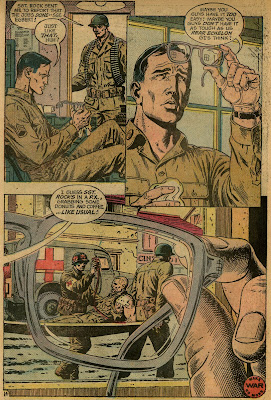
The last panel, taking up half the page, is the view through Egbert’s glasses as he holds them up, looking out through a window into the street—where Rock is being carried along in a stretcher, bandaged and bloody. Heath’s strong art had held the story together—now it provided it with a jarring, effective conclusion. Once again, it was a single image that is both a necessary part of the story and a masterpiece of comic art all on its own.
Monday, December 10, 2007
B-Movie Detectives: Part 4
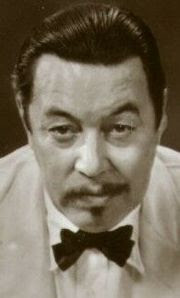
Friday, December 7, 2007
THE WEIRD CIRCLE

Tuesday, December 4, 2007
Nick Carter: Master Detective
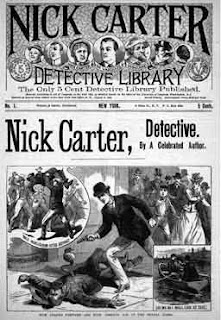
Nick Carter’s father trained him almost from birth to be an expert detective. He was developed physically into an immensely strong and expert fighter (with both fists and guns) and taught everything from science to art to languages to acting and disguise tricks. Though small in stature, his physical strength earned him the nickname Little Giant and he was said to be able to “fell an ox with one blow of his small, compact fist.” He was good at just about everything and eventually put his many talents to work bringing criminals to justice. He usually operated out of New York City, but he traveled around often enough to foil evil plots the world over. He seemed happy enough, though one can’t help but wonder if he didn’t occasionally look out at a sandlot ball game and let out a soft sigh of regret.
Nick’s first appearance was in “The Old Detective’s Pupil, or the Mysterious Crime of Madison Square,” published in the September 18, 1886 issue of the New York Weekly. The Weekly was one of hundreds of dime novels that ruled over popular literature during the latter half of the 19th Century. The term "dime novel” was something of a misnomer. The phrase was coined in 1858, when the publishing firm Beadle and Adams began to issue a series of novel-length books that cost a dime apiece. Within a few years, “dime novel” was the generic expression for any regularly published source of popular fiction—most were pamphlet-sized booklets that cost a nickel.
At first, the most popular dime novels were frontier stories or westerns, but after the Civil War, with industrialization drawing more and more of the population into the cities, a more urban hero was needed. The first detective character to regularly appear in a dime novel series was named Old Sleuth, who solved his first case in 1872. He was soon joined by hundreds of other detectives, with the genre eventually outselling the westerns.
When Nick Carter joined the crowd in 1886, he was in many ways no different from the rest. He, like nearly all his peers, was an expert in disguise who solved his cases by following the bad guys around, listening in on their conversations, avoiding a death trap or two, then making his arrests. The same sort of contrived plots and stilted dialogue that cursed the rest of the dime novel universe infested Nick’s tales as well.
But Nick managed to stand out from the rest. He appeared in over 1,000 dime novels, most of them written by Frederic Merrill van Renssalaur Dey, whose contribution to the Nick Carter mythos eventually totaled about 20,000,000 words. Nick was still around when the last of the dime novels faded away in 1915, then jumped to the pulp magazines. Original stories were still being regularly written about Nick for Detective Story Magazine through 1927, with reprints and a few smatterings of new material still popping up in various places through the 1940s. There were, of course, a few B-movies and a number of comic book appearances.
What kept Nick going when most other dime novel cops faded away? For one thing, Nick’s origin was fairly original and some of his individual tricks of the trade (such as keeping a revolver in a spring-loaded holster up each of his sleeves) were kind of neat. The villains he encountered stood out from the crowd as well. His eventual arch-enemy, mad scientist and serial killer Dr. Jack Quartz, was the perhaps the most memorable, but Nick also went up against more than his share of ruthless females: Zanoni the Woman Wizard and Zelma the Female Fiend being just two examples.
In an effort to give younger readers someone with whom to directly identify, Nick eventually acquired help from a number of youthful assistants. Chick Valentine was a “homeless waif” rescued by Nick and eventually adopted by him. Patrick “Patsy” Walker was a newsboy/shoe shine boy who also joined Nick’s growing crew of young crimebusters. Ten Ichi was a son of the Emperor of Japan, sent to Nick to learn detective skills for reasons never really explained. Other assistants, both male and female, came and went.
For a two-year period from 1895 to 1897, Nick retired from active investigations to run a detective school for boys. Dime novel readers were treated to the adventures of these intrepid students, with Nick acting as advisor and mentor. Then Nick abruptly returned to duty and his poor students were never mentioned again.
None of this would ever help qualify a Nick Carter dime novel as great literature, but all of it was potentially useful fodder for entertaining melodrama. Sadly, few if any of Nick’s stories stand the test of time. Popular fiction of this sort can make for wonderful escapism—characters from a few decades later such as Zorro or the Shadow are examples of this. But such stories require good, solid plots that make sense in the context of the fictional world in which they are set. Most importantly, the hero must fight or think his way out of trouble on his own merits. Too many of Nick’s stories depend on plain dumb luck to allow them to be truly satisfying.
In “Nick Carter, Detective: The Solution of a Remarkable Case,” from 1891, Nick investigates the mysterious death of popular dancer Eugenie La Verde, who had been strangled in her bed. ( “…the murderer had left not a single clew, however slight, by which he could be traced.”)
Nick is asked to investigate. Donning a disguise for no other reason than he always dons a disguise, he searches the crime scene. He finds nothing useful there, but when stopping for lunch at a nearby restaurant, he happens to overhear two thugs discussing the murder. So his big break in the case comes—as it all too often did—through plain dumb luck. Why his dad put all that time and effort into actual detective training is beyond analysis.
What follows is not all bad. Nick is captured by the villains, but escapes. It turns out one of the bad guys is a snake charmer—Eugenie was strangled by a python and Nick must dodge a cobra attack. At the climax, the snake charmer is crushed by one of his own pets.
It’s frustratingly close to being fun, but the dependence on dumb luck and the fact that the crooks always happen to be talking about important matters when Nick is hiding nearby pretty much spoils it.
In “Scylla, the Sea Robber; or, Nick Carter and the Queen of the Sirens,” from 1905, Nick goes up against the lady pirate Scylla and her crew of thirteen lovely distaff cutthroats. He’s captured and taken to their underwater base, accessible through a secret entrance in a government buoy marker. Nick is tossed into the ocean with 100 pounds of iron tied to his legs—only to be rescued through the most unforeseen and poorly explained deus ex machina in the history of fiction. Once again, the reader desperately wants to enjoy the story, but his desire for escapism is crushed under the weight of too many awkward contrivances.
It was on radio that Nick Carter finally comes through for us. The Return of Nick Carter premiered on the Mutual network in 1943. Soon re-titled Nick Carter, Master Detective, it ran for 12 years, with Lon Clark playing Nick for the entire run. For most of its existence, it was a standard half-hour show, but it did try out a 15-minute serialized format for a short time in 1944.
For radio, most of Nick’s young assistants were dropped. In a sort of literary sex-change, “Patsy” Walker, shoe-shine boy, became Patsy Bowen, lovely girl secretary, played first by Helen Choate and later by Charlotte Manson. Nick’s adopted son Chick also popped up in the spin-off series Chick Carter, Boy Detective, which ran on Mutual from 1945-47.
Nick was still a private detective, though like many other radio detectives he rarely seems to accept a fee for his work. (In a 1946 episode, he does mention that at least one insurance company keeps him on retainer.) Occasionally, he stumbled across a murder, but it’s more usual for the police or another interested party to come to him for help. The show had a fun opening—someone would be knocking persistently on a door. Patsy would open the door and ask “What is it?” “Another case!” was the inevitable answer.
Played with steady intelligence by Clark, Nick became a worthy addition to the traditional detective genre. The stories were interesting and the clues were fairly presented as Nick depended on actual deductive reasoning to solve cases. He was still quite capable in a fight and still an expert with disguises, though this last trait was no longer so badly overused. But mostly he depended on his brains.
In “Double Disguise; or, Nick Carter and the Mystery of the Kidnapped Heiress,” (the show kept the dime novel tradition of using double titles), Nick runs across an attempt to frame an innocent man named Chester Brown for murder. The motive is to steal a fortune that Brown’s wife was about to inherit. Nick deduces the identity of the real killer as an old enemy named Bartow and attempts to infiltrate the crook’s hideout while in disguise. But it’s a trap—Bartow set things up to lure Nick there and quickly sees through the disguise. Nick and Brown, who has also been captured, are hanged from the ceiling and left rapidly strangling to death. Bartow and his men flee as the police enter the building.
Nick, in the meantime, has employed the old Houdini trick of tensing his hands when he was tied up in order to gain enough slack to wiggle free. He uses a small knife hidden in his tie clasp to cut himself and Brown free. Then he and the police tail Bartow to yet another hideout, where they get the drop on him.
The dime novel conceits of captures and death traps were still there, but they were elements that fit naturally within a well-plotted story, with Nick’s deductive skills being nicely emphasized throughout. Other episodes didn’t worry as much about getting Nick into a death trap, but were content with allowing him to show off his cerebral skills. A 1945 episode titled “The Make-Believe Murder,” for instance, begins with an invitation for Nick to join the exclusive Alphabet Club. For his initiation, he must solve a make-believe murder staged by club members for his benefit. But one of the members is murdered for real during the fake investigation, shot dead when the lights go out. The only gun in the room, though, was a toy cap pistol. Later, another club member was murdered with a toy sword.
Nick figures it all out by the end, of course, identifying both murderer and motive and deducing how the toy gun had been rigged to fire a real bullet. It was, once again, well-written and completely fair to the audience in the presentation of the clues. This quality was maintained throughout the run of the show. Finally, here was a Nick Carter whose adventures we can enjoy with a clear conscience.
Monday, December 3, 2007
B-Movie Detectives: Part 3

Well, we've looked at a couple of reformed thieves, so now let's turn to one of the more famous of the B-movie law enforcement officers.
Chester Gould's briliant comic strip Dick Tracy first came to the big screen in 1937, as a 15-chapter serial starring Ralph Byrd as the heroic cop. Well, actually, in the serial, he's an heroic G-man, rather than the city cop he is in the original strip. But it's a well-made serial, as were the 2 serials that followed over the next few years.
But even though those the serials are fun, I prefer the four feature films made by RKO during the 1940s, in which Tracy was returned to his proper role as a big-city detective. The first two star Morgan Conway as Tracy. Conway gives a strong, understated performance--but for many fans, Ralph Byrd WAS Dick Tracy. Public demand brought Byrd back to the role for the last two films.
All four films are well-plotted, faithful to Gould's strip in that they contained the elements of a straightforward police procedural, but the villains were cartoonishly monsterous.
Dick Tracy Meets Gruesome, one of the Byrd films, is the best example of this. Boris Karloff plays the bad guy--the movie plays this just a little tiny bit tongue-in-cheek. But Karloff is still legitimately threatening, making him effective from a dramatic point-of-view as well.
There's another element to these movies I took note of when I watched a couple of them again recently. Gruesome ends with a gun fight between Tracy and the villain in the villain's hideout, where he has a conveyor belt/furnace set up for dispossing of bodies. Dick Tracy, Detective (one of the Conway films) ends with the square-jawed cop and the bad guy slugging it out with their fists aboard a dilapitated old riverboat.
In both cases, these action sequences were just plain fun to watch. The camera remained steady and everything was choreographed in such a way that we could follow the action. We understand the geography of the situation and we know where all the participants are in relation to each other at any one time.
In these days of split-second edits and endlessly jiggling cameras (what has been justifiably called the "vomit-cam"), it is more and more of a pleasure to watch a good 0ld-fashioned action scene. I am increasingly of the opinion that many otherwise talented contemporary directors simply don't know how to choreograph and photograph a fight scene and thus use the vomit-cam to cover up their shortcomings.
This is not the case in with the Dick Tracy movies--or just about any of the B-movies from that era. They knew how to film a fight scene, by golly.






